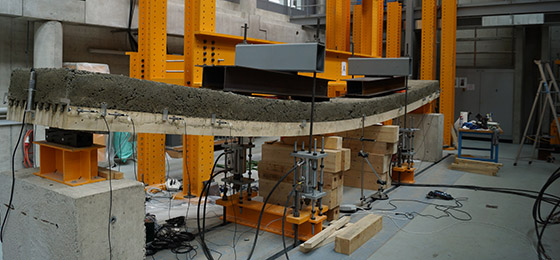Concrete from wood

Researchers from the National Research Programme "Resource Wood" have developed a type of concrete that largely consists of wood. The building material offers the construction industry new possibilities and is based in large part on renewable resources.
Houses can be made of wood, as they were in the past – or of concrete, as they are today. To build for tomorrow, the two building methods are being combined: these hybrid structures, which contain both wood and concrete elements, are becoming increasingly popular in contemporary architecture.
In the context of the National Resource Programme “Resource Wood” (NRP 66), Swiss researchers have now developed an even more radical approach to combining wood and concrete: they are fabricating a load-bearing concrete which itself consists largely of wood. In many blends, the volume fraction of the wood is over 50 percent.
Cement-bonded wood products have been around for more than a hundred years. Yet previously they were used only for non-load-bearing purposes, such as insulation. Daia Zwicky, head of the Institute for Building and Environmental Technologies at the School of Engineering and Architecture of Fribourg, wondered whether it wasn't time for a more ambitious use of wood-based concrete.
Floating concrete
Together with his team, Zwicky experimented with the content and granularity of the wood as well as diverse additives and subsequently subjected the various blends to rigorous tests. The main difference from classical concrete is that the gravel and sand content is replaced with finely ground wood. In other words, sawdust rather than small stones is mixed in with the cement. Thanks to the high wood content, the new building materials show good flame retardance and act as thermal insulation.
“They weigh at most half of what normal concrete weighs – the lightest of them even float!” says Zwicky. Moreover, as the materials are based largely on renewable resources, after dismantling they can be reused as a source of heat and electricity. The wood content can be burnt in waste incineration, although for everyday use it conforms to fire protection standards.
Initial 1:1 stress tests show that the new wood-based concrete is also suitable for slab and wall elements and can provide a load-bearing function in construction. The process is also suited to prefabricated units. In this context, in particular, the Fribourg group would like to deepen their expertise through a broader range of tests. The researchers want to find out which wood-concrete composite is best for which applications, and how it can be produced efficiently.
“It will take several years before we see the first buildings in which lightweight concrete containing wood plays an integral role in the construction,” says Zwicky. “The level of knowledge required for widespread application is still too limited.”
Resource Wood (NRP 66)
In collaboration with industry, forest owners and authorities, the National Research Programme “Resource Wood” (NFP 66) aims to generate scientific insights and practical solutions to optimize the exploitation and use of wood in Switzerland. The overall final recommendations of NRP 66 will be published in four topical summary reports at the end of 2017. The Swiss National Science Foundation (SNSF) was commissioned by the Federal Council to run the programme.
National Research Programme (NRP 66)
Contact
Daia Zwicky
Institut für Bau- und Umwelttechnologien iTEC
HES-SO Hochschule für Technik und Architektur Fribourg
CH-1705 Fribourg
Tel. +41 26 429 69 50
E-mail daia.zwicky@hefr.ch
Publications
M. Maeder and D. Zwicky: Multi-functional features of pourable wood-cement compounds – mechanical, building-physical, economic and ecological performance. World Conference on Timber Engineering, At Vienna, Austria (August 2016).
M. Eymard and D. Zwicky: Slab elements made of timber and wood-cement compounds – structural and other performances. 3rd International Conference on Structures and Architecture, Guimarães (July 2016).
D. Zwicky and N. Macchi: Wall elements made of timber and wood-cement compounds – building-physical properties and structural performance. 3rd International Conference on Structures and Architecture, Guimarães (July 2016).
http://www.snsf.ch/press-releases Press release
http://www.snf.ch/en/researchinFocus/newsroom/Pages/news-170705-press-release-co…
http://www.nrp66.ch/ National Research Programme (NRP 66)
http://www.nrp66.ch/en/projects/dialogue-field-1-advancements-in-timber-construc… NRP 66 project “Wood and wood-based concrete”
http://www.snf.ch/SiteCollectionImages/Medienmitteilungen/170705_MM_NFP66_Holzbe… Download image (JPG, 4.3 MB)
Media Contact
All latest news from the category: Architecture and Construction
Newest articles

First-of-its-kind study uses remote sensing to monitor plastic debris in rivers and lakes
Remote sensing creates a cost-effective solution to monitoring plastic pollution. A first-of-its-kind study from researchers at the University of Minnesota Twin Cities shows how remote sensing can help monitor and…

Laser-based artificial neuron mimics nerve cell functions at lightning speed
With a processing speed a billion times faster than nature, chip-based laser neuron could help advance AI tasks such as pattern recognition and sequence prediction. Researchers have developed a laser-based…

Optimising the processing of plastic waste
Just one look in the yellow bin reveals a colourful jumble of different types of plastic. However, the purer and more uniform plastic waste is, the easier it is to…



